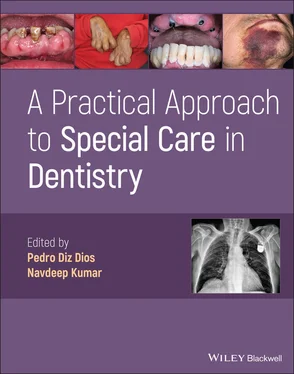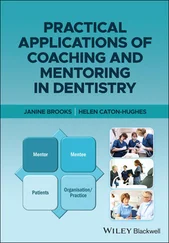A Practical Approach to Special Care in Dentistry
Здесь есть возможность читать онлайн «A Practical Approach to Special Care in Dentistry» — ознакомительный отрывок электронной книги совершенно бесплатно, а после прочтения отрывка купить полную версию. В некоторых случаях можно слушать аудио, скачать через торрент в формате fb2 и присутствует краткое содержание. Жанр: unrecognised, на английском языке. Описание произведения, (предисловие) а так же отзывы посетителей доступны на портале библиотеки ЛибКат.
- Название:A Practical Approach to Special Care in Dentistry
- Автор:
- Жанр:
- Год:неизвестен
- ISBN:нет данных
- Рейтинг книги:3 / 5. Голосов: 1
-
Избранное:Добавить в избранное
- Отзывы:
-
Ваша оценка:
- 60
- 1
- 2
- 3
- 4
- 5
A Practical Approach to Special Care in Dentistry: краткое содержание, описание и аннотация
Предлагаем к чтению аннотацию, описание, краткое содержание или предисловие (зависит от того, что написал сам автор книги «A Practical Approach to Special Care in Dentistry»). Если вы не нашли необходимую информацию о книге — напишите в комментариях, мы постараемся отыскать её.
Learn to treat dental patients with disabilities or who are medically compromised A Practical Approach to Special Care in Dentistry
A Practical Approach to Special Care in Dentistry
A Practical Approach to Special Care in Dentistry — читать онлайн ознакомительный отрывок
Ниже представлен текст книги, разбитый по страницам. Система сохранения места последней прочитанной страницы, позволяет с удобством читать онлайн бесплатно книгу «A Practical Approach to Special Care in Dentistry», без необходимости каждый раз заново искать на чём Вы остановились. Поставьте закладку, и сможете в любой момент перейти на страницу, на которой закончили чтение.
Интервал:
Закладка:
The most common infectious agent is M. tuberculosis
The bacilli access the lungs (in the form of aerosol droplets), are phagocytised by macrophages and transferred to regional lymph nodes
Haematogenous dissemination then occurs
The granulomatous lesions (tubercles) contain living bacilli and develop by a delayed hypersensitivity mechanism
Clinical Presentation
Globally, tuberculosis notification data show a male‐to‐female ratio of 1.7:1 and higher, although the underlying reasons for the male bias remain unclear
Latent tuberculosisThe initial infection is usually asymptomaticApproximately one‐quarter of the world's population has latent tuberculosis – at this stage, they cannot transmit the infection
Active primary tuberculosis diseasePeople infected with tuberculosis bacteria have a 5–15% lifetime risk of progressing to develop tuberculosis diseasePersons with compromised immune systems, such as those living with HIV, malnutrition or diabetes, or people who use tobacco, have a higher risk of developing the diseaseSymptoms include fever, night sweats, cough, asthenia, anorexia and lymphadenopathyThe symptoms may be mild and persist for many months, leading to delays in seeking care, and in transmission of the bacteria to othersPulmonary impairment may progress, resulting in a productive cough, rales (abnormal rattling sound from the lungs) and, in highly advanced stages, haemoptysisOccasionally, there is extrapulmonary dissemination, which can affect the central nervous system, bones and cardiovascular, genitourinary and gastrointestinal systemsSome particularly prevalent conditions such as alcoholism, drug addiction, cancer, diabetes and HIV infection can alter the clinical presentation of tuberculosisWithout appropriate treatment, approximately 45% of HIV‐negative people with tuberculosis and nearly all HIV‐positive people with tuberculosis will die
Tuberculosis recurrenceLatent tuberculosis is associated with 5–10% chance of reactivation, usually within the first 2 years of infectionRecurrence can be due to either reactivation of the same strain, i.e. relapse, or reinfection with a new strainRecurrence due to reinfection is more likely in endemic settings with high rates of HIV coinfection
Diagnosis
The acquisition of skin reactivity to the tuberculin purified protein derivative or Mantoux test is considered suggestive of tuberculosis ( Figure 4.1.3)
Chest radiography helps establish the suspected diagnosis for patients with symptoms ( Figure 4.1.4)
Sputum smears have poor sensitivity Figure 4.1.3 Positive Mantoux test (also known as tuberculin PPD test for purified protein derivative). Figure 4.1.4 Chest x‐ray showing cavitary lesions typically associated with active pulmonary tuberculosis.
Sputum cultures provide the definitive diagnosis, but the results are not obtained for up to 4–8 weeks
PCR provides a rapid and reliable diagnosis
For extrapulmonary tuberculosis, a histopathological analysis of the infected organs should be conducted . It is characterised by the presence of caseating granulomas formed by epitheloid macrophages surrounging an acelluar necrotic region
Management
The most widely used regimen is the administration of 4 drugs (isoniazid, rifampicin, pyrazinamide, and ethambutol) for 2 months, followed by 2 drugs (isoniazid and rifampicin) for another 4 months
Multidrug‐resistant tuberculosis is an increasing concern – the disease does not respond to isoniazid and rifampicin, the 2 most powerful medications used to treat the disease
Alternatives in this situation include diarylquinoline and nitroimidazole
Treatment regimens can be prolonged, typically lasting 6–12 months
Treating recurrent tuberculosis that is caused by relapse is challenging as often the bacteria have become resistant to treatment and a different combination of drugs, taken over a longer period of time, is required
Hence recurrent tuberculosis disease is associated with poor treatment outcomes and higher mortality rates compared to primary tuberculosis infection
Prognosis
About 5% of patients infected by M. tuberculosis develop active tuberculosis in the first 2 years post exposure
The incidence of drug‐resistant tuberculosis is increasing exponentially
Although tuberculous mortality has fallen substantially in the past 20 years, it is estimated that 3 million individuals die annually due to complications from this disease
About 25% of those who die have concurrent HIV infection
A World/Transcultural View
There is a strong association between the incidence of tuberculosis and a country's gross domestic product per capita
Marginalised and socially disadvantaged populations, such as indigenous populations, ethnic minorities, immigrants and prisoners, also have a higher incidence of tuberculosis
Poorer treatment results have been recorded in groups with low socio‐economic levels, probably because they have limited access to high‐quality care
Although drug‐resistant strains have been previously diagnosed in highly endemic settings, resistance to numerous drugs constitutes a significant problem in the industrialised world
Recommended Reading
1 Dheda, K., Barry, C.E. 3rd, and Maartens, G. (2016). Tuberculosis. Lancet 387: 1211–1226.
2 Faecher, R.S., Thomas, J.E., and Bender, B.S. (1993). Tuberculosis: a growing concern for dentistry? J. Am. Dent. Assoc. 124: 94–104.
3 Feller, L., Wood, N.H., Chikte, U.M. et al. (2009). Tuberculosis part 4: control of Mycobacterium tuberculosis transmission in dental care facilities. SADJ 64: 408–410.
4 González Mediero, G., Vázquez Gallardo, R., Pérez Del Molino, M.L., and Diz Dios, P. (2015). Evaluation of two commercial nucleic acid amplification kits for detecting Mycobacterium tuberculosis in saliva samples. Oral Dis. 21: 451–455.
5 Jensen, P. A., Lambert, L. A., Iademarco, M. F., Ridzon, R., & CDC ( 2005). Guidelines for preventing the transmission of Mycobacterium tuberculosis in health‐care settings, 2005. MMWR Recomm Rep. 54 (RR‐17): 1–141.
6 Rinaggio, J. (2003). Tuberculosis. Dent. Clin. North Am. 47: 449–465.
7 Sharma, S., Bajpai, J., Pathak, P.K. et al. (2019). Oral tuberculosis – current concepts. J. Family Med. Prim. Care. 8: 1308–1312.
4.2 Human Immunodeficiency Virus (HIV) Infection/AIDS
Section I: Clinical Scenario and Dental Considerations
Clinical Scenario
A 45‐year‐old man is referred by his physician for assessment of extensive but painless oral papillomatous lesions.
Medical History
Stage 3 human immunodeficiency virus (HIV) infection (HIV infection diagnosed 14 years ago)
Cryptococcal meningitis (without sequelae)
Kaposi sarcoma of the skin
Chronic hepatitis B virus (HBV) infection
Anal squamous cell carcinoma
Adjustment disorder and depressed mood
Medications
Ritonavir (RTV)
Emtricitabine (FTC) + tenofovir (TDF)
Citalopram
Dental History
Irregular dental attender
Moderate level of co‐operation
Patient brushes his teeth twice a day
Social History
Lives with his male partner (who is HIV negative)
Works in a car company as a welder
Alcohol and tobacco consumption: discontinued 10 years ago
Oral Examination
Fair oral hygiene
Numerous exophytic lesions (sessile/flat and pedunculated) that preferentially involve the lips, retrocommissural area and palate; clinically suggestive of warts
Читать дальшеИнтервал:
Закладка:
Похожие книги на «A Practical Approach to Special Care in Dentistry»
Представляем Вашему вниманию похожие книги на «A Practical Approach to Special Care in Dentistry» списком для выбора. Мы отобрали схожую по названию и смыслу литературу в надежде предоставить читателям больше вариантов отыскать новые, интересные, ещё непрочитанные произведения.
Обсуждение, отзывы о книге «A Practical Approach to Special Care in Dentistry» и просто собственные мнения читателей. Оставьте ваши комментарии, напишите, что Вы думаете о произведении, его смысле или главных героях. Укажите что конкретно понравилось, а что нет, и почему Вы так считаете.












